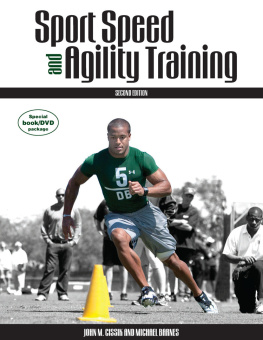
Bigger Faster Stronger
Third Edition
Greg Shepard, EdD
Kim Goss

Library of Congress Cataloging-in-Publication Data
Names: Shepard, Greg, 1942- author. | Goss, Kim, 1956- author.
Title: Bigger, faster, stronger / Greg Shepard, EdD, Kim Goss.
Description: Third Edition. | Champaign, IL : Human Kinetics, [2017] | Second
edition: 2009. | Includes webography. | Includes index.
Identifiers: LCCN 2016052501 (print) | LCCN 2017000862 (ebook) | ISBN
9781492545811 (print) | ISBN 9781492545828 (ebook)
Subjects: LCSH: High school athletes--Training of. | School sports. |
Physical education and training--Study and teaching (Secondary)
Classification: LCC GV346 .S55 2017 (print) | LCC GV346 (ebook) | DDC
613.7/11--dc23
LC record available at https://lccn.loc.gov/2016052501
ISBN: 978-1-4925-4581-1 (print)
Copyright 2017, 2009 by Bigger Faster Stronger, Inc.
Copyright 2004 by Greg Shepard
All rights reserved. Except for use in a review, the reproduction or utilization of this work in any form or by any electronic, mechanical, or other means, now known or hereafter invented, including xerography, photocopying, and recording, and in any information storage and retrieval system, is forbidden without the written permission of the publisher.
This publication is written and published to provide accurate and authoritative information relevant to the subject matter presented. It is published and sold with the understanding that the author and publisher are not engaged in rendering legal, medical, or other professional services by reason of their authorship or publication of this work. If medical or other expert assistance is required, the services of a competent professional person should be sought.
Notice: Permission to reproduce the following material is granted to instructors and agencies who have purchased Bigger Faster Stronger, Third Edition: pp. 199-212. The reproduction of other parts of this book is expressly forbidden by the above copyright notice. Persons or agencies who have not purchased Bigger Faster Stronger, Third Edition , may not reproduce any material.
The web addresses cited in this text were current as of April 2017, unless otherwise noted.
Acquisitions Editors: Justin Klug and Jeff Mathis
Developmental Editor: Anne Hall
Managing Editor: Stephanie M. Ebersohl
Copyeditor: Janet Kiefer
Indexer: Alisha Jeddeloh
Permissions Manager: Martha Gullo
Graphic Designer: Julie Denzer
Cover Designer: Keith Blomberg
Photograph (cover): Human Kinetics and Bigger, Faster, Stronger, Inc.
Photographs (interior): Bigger, Faster, Stronger, Inc., unless otherwise noted
Photo Production Manager: Jason Allen
Senior Art Manager: Kelly Hendren
Illustrations: Human Kinetics
Printer: Sheridan Books
Human Kinetics books are available at special discounts for bulk purchase. Special editions or book excerpts can also be created to specification. For details, contact the Special Sales Manager at Human Kinetics.
Printed in the United States of America
10 9 8 7 6 5 4 3 2 1
The paper in this book is certified under a sustainable forestry program.
Human Kinetics
Website: www.HumanKinetics.com
United States: Human Kinetics
P.O. Box 5076
Champaign, IL 61825-5076
800-747-4457
e-mail: info@hkusa.com
Canada: Human Kinetics
475 Devonshire Road Unit 100
Windsor, ON N8Y 2L5
800-465-7301 (in Canada only)
e-mail: info@hkcanada.com
Europe: Human Kinetics
107 Bradford Road
Stanningley
Leeds LS28 6AT, United Kingdom
+44 (0) 113 255 5665
e-mail: hk@hkeurope.com
For information about Human Kinetics coverage in other areas of the world, please visit our website: www.HumanKinetics.com.
E7001
Contents
Introduction
Forty years ago the Bigger Faster Stronger program was developed by Dr. Greg Shepard, who worked as a high school, college, and professional strength coach. In 1979 Bob Rowbotham joined the Bigger Faster Stronger team as a clinician, and he eventually took over the company as president and later CEO. Although there have been many advances in the fields of athletic and physical fitness since Coach Shepard began sharing his training methods with coaches and athletes, the principles BFS was founded on have not changed. Coach Rowbotham has made certain of that.
The BFS program originated from working with world-class track and field athletes, athletes who often displayed exceptional levels of strength, power, and explosiveness, says Rowbotham. When the company started, the only athletes who were using the weight room were football players and the throwers in track and field. Consequently, BFS was perceived to be a football programits taken a long time to change that perception.
The BFS program was based upon the training of elite track and field athletes, such as Jon Cole. Cole was a world-class thrower who broke world records in powerlifting and competed in the Olympic trials in weightlifting.

Courtesy of Bruce Klemens
In addition to providing strength and conditioning clinics to coaches and their athletes, Rowbotham and his staff spread the word about BFS by attending conventions for state and national physical education organizations, such as SHAPE America. The appeal of BFS grew as sports coaches, strength coaches, and physical education instructors saw the benefit of working together in a unified program that fulfills not only the needs of athletes but also those in the fitness-orientated environment. Rowbotham says he is also pleased to discover that the BFS principles have been verified by scientific research, such as the superiority of the hex bar deadlift over the straight-bar deadlift.
Rowbotham also soon saw a need for a certification program for coaches to expand on many aspects of running a unified program. He says, Our certifications started in 2005 because of the concern about safety and liability in the school environment, and because weight training was becoming more popular with athletes in other sports and students involved in physical education classes. These topics would be better addressed in a specific seminar for those administrating the program, rather than in a general clinic for both coaches and athletes.
Asked what changes he has seen in the last 10 years in the school system, Rowbotham replied, One of the biggest challenges is in the structure of the curriculum. We dont have the physical requirements for physical education that we had 20 years ago. Some schools only require one semester of physical education for their entire four years, and others have made physical education an entirely elective-based environment. Based upon our experience, when the weight room is set up correctly, weight training becomes one of the most popular classes in the PE curriculum. Schools that have developed an elective program in conjunction with the athletic team environment is where BFS has grown the most.
Because the competitive sports environment is so much higher today, Rowbotham believes its especially important for athletes to be involved in the weight room. He has found that Coaches, athletes, and parents understand that now. They also understand that strength is just one component of developing the total athlete. Strength training, in conjunction with other aspects of conditioning, presented in a format that produces progressive gains over time that can be measured objectively, is key to the success of BFS.














